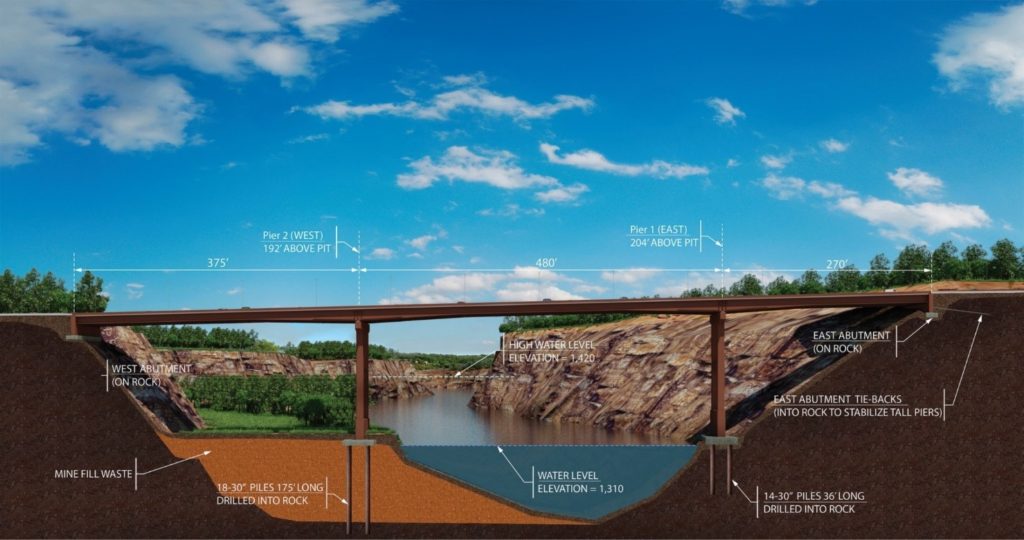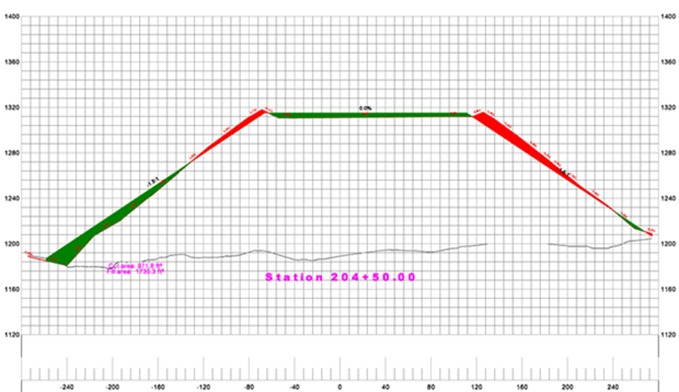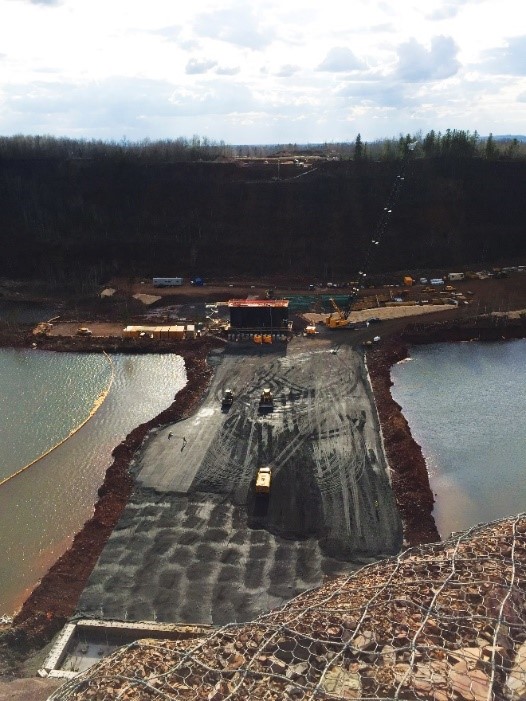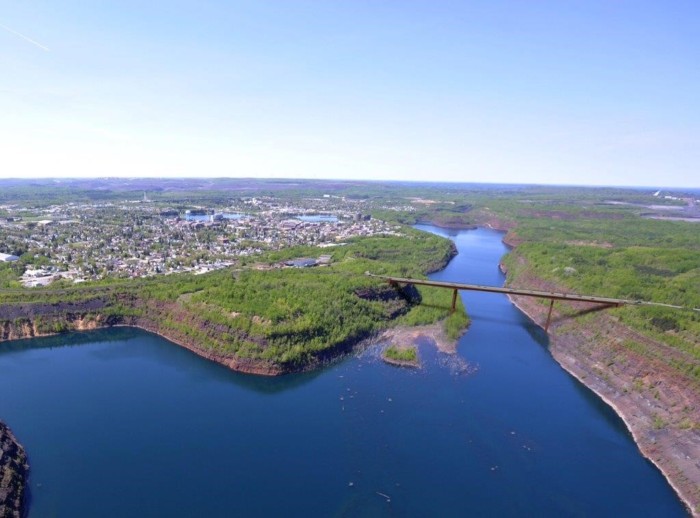Trunk highway 53 (TH 53), located south of Virginia, Minnesota, was built in 1960 on land owned by iron mining interests. In 2010, these mining interests notified MnDOT that a portion of the roadway in Virginia would need to be relocated to provide access to valuable natural resources. The new alignment would require the construction of a 1,100-foot bridge across the massive Rouchleau Pit, an abandoned open-pit mine. Open since September 2017, the bridge is the tallest in Minnesota.
The significant height requirements for the bridge created challenges for construction and a causeway was needed to provide access for construction activities at the base of the bridge.雷竞技好Newbee赞助商was retained to design a temporary rock causeway to support varied surface loading from construction equipment and shoring towers, as well as the Terex CC 6800 heavy-lift crawler crane which lifted bridge girders some 200 feet in the air to construct the TH 53 Bridge which crosses the Rouchleau Pit.
Causeway Design and Construction
一般而言,堤道横跨小溪和溪流构建,深度最小,令人震惊的坑是一种巨大的露天矿,所以需要一个临时堤道测量大约500英尺的堤坝。完整的铜锣车深度达110英尺,水线上方有五英尺。这种堤道的尺寸,规模和深度推动了堤道设计和施工的界限。

堤道的设计和施工需要多种创新措施,包括:
1.Slope monitoring underwater using sonar
The mine-blasted rock which was used as fill in the causeway construction was very angular, which made determining the slope geometry of the causeway difficult. Kiewit, the general contractor for this project, surveyed the rock pit using an Echo Sounder C4 Hydro Lite System, with a transducer set into holes drilled through the ice, on a 25-foot grid and took readings to verify the depths and slope geometry. A topographical survey, obtained with the Echo Sounder C4 Hydro Lite System, was created. Using the survey as a tool, additional rock was placed in areas to achieve design slopes.

2.Load transfer at surface using geogrid
Loads anticipated from surface loading ranged from 2600psf to 7500psf, with the largest loading coming from the crane performing bridge construction. To accommodate this significant surface weight, the project team proposed a causeway design comprised of four zones. Due to the varying depths present in the Rouchleau Pit, the design needed to account for strength changes resulting from rocks at lower elevations crushing from the weight of rocks above. To reduce the required thickness of the rocks at the surface of the causeway, the team implemented a Tensar BX1200, polypropylene bi-axial geogrid, which provided a safe and stable surface to perform construction activities.

Project Challenges
The location, scope, and sheer size of the causeway posed many challenges to the project team members. One challenge the project team faced was creating a causeway that was wide enough to provide a safe and stable surface for construction activities, while also meeting the budget requirements. Because of these requirements, the causeway design needed to address many complexities, such as varied surface loading of heavy construction equipment and shoring towers, which included the enormous Terex CC 6800 heavy-lift crawler crane used to lift bridge girders.
堤道的深度构成了自己的许多复杂挑战。被回收的铁矿石岩石用于施工,这非常密集,角度粗糙。由于罗回坑中存在的深度不同,堤道设计需要考虑由岩石在较低的岩石中挤压上述岩石的重量而导致的强度变化。堤道斜坡采用斜坡/瓦设计,设计软件直至建模不同强度特性的挑战。雷竞技好Newbee赞助商Braun InterteC还使用了Plaxis,是一个有限元程序,可以在不同的负载条件下模拟应力分布。

在为该堤道设计的四个区域中,通过熟练的设备操作员进行水下区域4的构造。施工过程包括越野拖车驾驶员在堤道现场倾倒材料,然后由大推土机推入摇摇欲坠的坑水。堤道4和4中使用的材料是从附近借用地区获得的铁矿石岩石中断。从借来的地区使用岩石的优势是它靠近项目现场,不到15分钟的往返卸载和负载。越野举行的卡车运输了大约325,000立方米的岩石,大约是180,055辆卡车。

Due to the agreement MnDOT had made with mining interests, the project team had strict deadlines in place to complete the causeway. Despite the complex challenges posed by the size, scope, and harsh winter weather, Braun Intertec was able to complete the causeway on budget and on schedule. With the causeway complete, construction of the bridge was complete and open to traffic in late 2017.
Want to learn more about solutions for varied surface loading of heavy construction equipment?
Sign up for our webinar “起重机垫设计:可以制造或违反项目的小细节” where you can learn about the complexities of designing a safe crane pad whatever the terrain; common crane pad design questions; and case studies of crane pad designs gone wrong.



